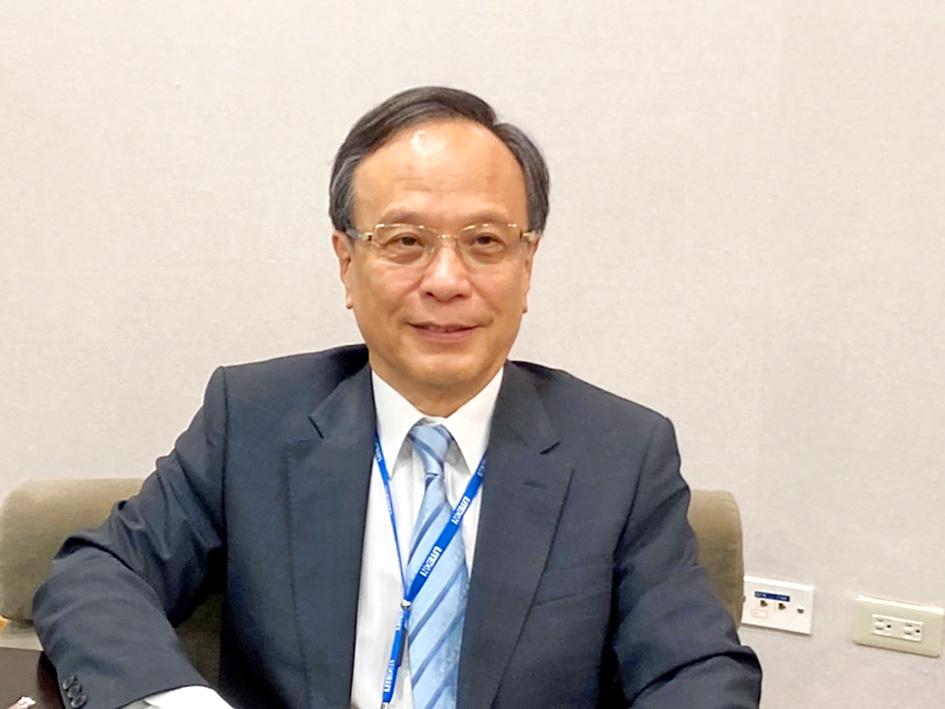Electronic component manufacturer Lite-On Technology Corp (光寶科技) yesterday gave a hazy outlook for business in the second half of the year due to the COVID-19 pandemic.
“From what we know, the coronavirus is still spreading, with new cases in Beijing, as well as in the US and South America… There is a lot of uncertainty which is fostering [economic] instability from a global perspective,” Lite-On vice chairman and chief operating officer Warren Chen (陳廣中) told a news conference after the company’s annual shareholders’ meeting in Taipei.
Although Lite-On has good order visibility for the third quarter, Chen expressed doubts about its future performance.

Photo: Chen Jou-chen, Taipei Times
“We can no longer rely on clients’ orders to predict market demand,” as clients could “easily delay or cancel” orders, Chen said.
The third quarter is usually the high season for electronics, but given the prevailing uncertainty, Chen forecast a year-on-year decline in sales in the second half of the year.
“Nevertheless, the second half would be better than the first half, as we would have more working days,” he said.
With production and shipments hampered by the COVID-19 outbreak in China, Lite-On’s first-quarter sales dropped 20.88 percent annually to NT$32.58 billion (US$1.09 billion).
Thanks to strong shipments of power supplies and other electronic components for PCs, servers, and networking and communications devices, the company reported sales of NT$13.75 billion in April, up 1.57 percent from a year earlier.
However, Lite-On saw sales plummet again by 7.3 percent year-on-year last month, as demand from the US shrank.
With the ongoing protests and high unemployment in the US, “it would be a long time before business returns to normal,” Chen said, adding that a full recovery is unlikely before the end of the year.
Lite-On has resumed operations at its plants in Mexico and Brazil, while its Indian plant remains partially closed, Chen said.
Its production sites in Kaohsiung, Thailand and Vietnam have not been affected by the pandemic, he added.
Focusing on shifting its production out of China, Chen said that Lite-On expects to ship about 20 percent of its total production — up from 15 percent at present — from these sites by the end of the year.
The company’s shareholders yesterday approved a cash dividend distribution plan of NT$3.2 per common share, representing a payout ratio of 79 percent based on earnings per share of NT$4.03 last year.

Shiina Ito has had fewer Chinese customers at her Tokyo jewelry shop since Beijing issued a travel warning in the wake of a diplomatic spat, but she said she was not concerned. A souring of Tokyo-Beijing relations this month, following remarks by Japanese Prime Minister Sanae Takaichi about Taiwan, has fueled concerns about the impact on the ritzy boutiques, noodle joints and hotels where holidaymakers spend their cash. However, businesses in Tokyo largely shrugged off any anxiety. “Since there are fewer Chinese customers, it’s become a bit easier for Japanese shoppers to visit, so our sales haven’t really dropped,” Ito

The number of Taiwanese working in the US rose to a record high of 137,000 last year, driven largely by Taiwan Semiconductor Manufacturing Co’s (TSMC, 台積電) rapid overseas expansion, according to government data released yesterday. A total of 666,000 Taiwanese nationals were employed abroad last year, an increase of 45,000 from 2023 and the highest level since the COVID-19 pandemic, data from the Directorate-General of Budget, Accounting and Statistics (DGBAS) showed. Overseas employment had steadily increased between 2009 and 2019, peaking at 739,000, before plunging to 319,000 in 2021 amid US-China trade tensions, global supply chain shifts, reshoring by Taiwanese companies and

Taiwan Semiconductor Manufacturing Co (TSMC, 台積電) received about NT$147 billion (US$4.71 billion) in subsidies from the US, Japanese, German and Chinese governments over the past two years for its global expansion. Financial data compiled by the world’s largest contract chipmaker showed the company secured NT$4.77 billion in subsidies from the governments in the third quarter, bringing the total for the first three quarters of the year to about NT$71.9 billion. Along with the NT$75.16 billion in financial aid TSMC received last year, the chipmaker obtained NT$147 billion in subsidies in almost two years, the data showed. The subsidies received by its subsidiaries —

Taiwan Semiconductor Manufacturing Co (TSMC) Chairman C.C. Wei (魏哲家) and the company’s former chairman, Mark Liu (劉德音), both received the Robert N. Noyce Award -- the semiconductor industry’s highest honor -- in San Jose, California, on Thursday (local time). Speaking at the award event, Liu, who retired last year, expressed gratitude to his wife, his dissertation advisor at the University of California, Berkeley, his supervisors at AT&T Bell Laboratories -- where he worked on optical fiber communication systems before joining TSMC, TSMC partners, and industry colleagues. Liu said that working alongside TSMC